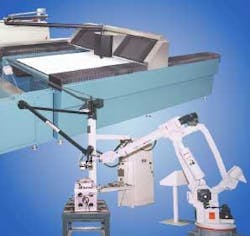Articulated arms are a proven, accurate, reliable and superior method for delivering laser energy and are beginning to gain greater acceptance as their many technical and economic benefits are recognized.
Although the current installed base of industrial articulated arms is only a few hundred units, the technology behind these arms is based on the same principles used on the more than 10,000 small-bore arms used for medical and dental applications. Industrial versions of these arms can now deliver 8kW, and above, of laser power.
Innovative laser system manufacturers realize that incorporating an articulated arm into their system design provides a competitive differentiator and simplified system configurations. End users are requesting more articulated arms as they experience for themselves the benefits in improved performance, simplified operation, reduced maintenance and lower operating costs.
null
The most popular application for industrial articulated arms utilizes the arm's flexibility to couple a CO2 laser with a multi-axis, industrial robot to provide the steerable beam delivery necessary for three-dimensional processing motion and location of the CO2 laser source. Another promising application takes advantage of an arm's constant path length and sealed enclosure to connect a CO2 laser to a flatbed sheet metal cutting machine, thereby replacing conventional flying optics. The constant path length ensures that the focal spot size and mode quality remain consistent and unchanged over the full range of the travel envelope—producing optimum cuts at all locations on the workpiece. System degradation from cutting process contaminants is prevented by the arm's sealed beam tubes.
Perhaps most novel is use of the articulated arm with Nd:YAG laser systems for micro-machining applications to produce very narrow cut kerfs or drill very small holes. Arm-delivered beams preserve the high beam quality of the Nd:YAG laser allowing near-diffraction-limited focal spots as small as 0.0001 in. The arm's inherent self-integral pointing stability allows the coupling of the laser source to the part-handling workstation without the need to rigidly connect the foundations or support structures of the respective units. This can greatly simplify machine design, especially in retrofit applications, as well as provide more stable alignment under harsh environmental conditions.
An articulated arm comprises rigid tubes made of aluminum or carbon fiber, with 45° mirrors mounted in rotary bearings, called knuckles, at the ends (see Figure 2). A typical arm assembly contains six knuckles and two long beam tubes as well as two short tubes called the input and output hubs. All of the mirrors and hubs are factory pre-aligned and never require readjustment unless mechanical damage has occurred to the arm. This type of construction offers considerable advantages over conventional beam delivery methods because all adjustment points are minimized to the entrance or output end of the arm.
Articulated arms offer advantages over other moving optic industrial laser systems. For example, it is important to control contaminants in the beam path, because only a few parts per million can cause dramatic blooming of the laser beam. The sealed volume within the arm makes it easy to provide a clean gas purge to eliminate this problem.
Maintaining mirror cleanliness in a laser machine is primarily dependent on keeping the beam path sealed and preventing contamination from dirt and debris. In standard machines the moving mirrors are typically contained within flexible bellows, or sliding tubes, which may introduce contamination through internal chaffing and can experience damage by sparks and debris from the process. Also, with these methods, as the beam path moves, a pumping action can occur, which may change the pressure environment within the beam path, tending to suck in outside air. Articulated arms eliminate this "dust pumping," which prematurely destroys expensive optics, and the beam path remains under constant pressure.
Because the beam path length never changes, laser beam properties remain stable in an articulated arm delivery system. The laser beam always travels a constant distance to the focusing lens, resulting in a fixed beam size at the lens. This produces a constant spot size and beam wavefront, with consistent process results throughout the full range of machine motion.
null
The arm's rigid tubing provides the maximum level of operator protection from high-power laser beams. In addition to the inherent safety of the solid metal enclosure, the arm can be provided with presence detectors that turn off the laser generator if a beam enters but does not simultaneously exit the arm.
Stability issues associated with attaching and aligning a laser to a motion system and maintaining accurate alignment in face of environmental disturbances are minimized. With an articulated arm, the laser needs no rigid connection to the machine to remain properly aligned to the cutting head.
Conventional laser systems may be adversely affected by seasonal temperature changes, floor motions, vibrations from nearby equipment and the sheer size of the structure. The articulated arm beam path is independent of the structural rigidity of the machine and the floor on which it is placed. This minimizes machine foundation requirements and structural requirements of the motion system and eliminates the necessity to integrate the laser source with the machine base. The laser can even be placed on wheels.
Articulated arms also significantly simplify machine maintenance, because the mirrors may have to be cleaned frequently, while an arm can go for longer periods without cleaning. When cleaning or replacement is needed, precision locating dowel pins allow all mirrors to be removable and replaceable without requiring system realignment.
With some conventional beam deliveries, if any component requires alignment, especially the laser, all components in the system may have to be realigned to compensate for the adjustments. In routine troubleshooting, there may be no way of knowing which of multiple mirrors might have moved, whether the laser moved relative to those mirrors, or whether the lens is simply out of position. With an articulated arm system there is only one adjustment point, which is the entrance into the arm, and realignment from a laser tune-up is achievable within one-half hour. For maintenance procedures, a simple chart of "problem vs. adjustment" can be made to eliminate the guesswork normally associated with laser system alignments.
Given their advantages in terms of performance, durability and ease of use, industrial articulated arms offer an alternative method of delivering a laser beam from the laser source to the workpiece.
William G. Fredrick is president of Laser Mechanisms Inc. (Farmington Hills, Michigan). For more information, contact [email protected].

